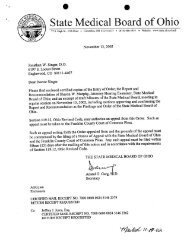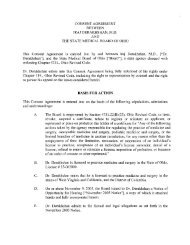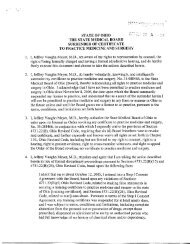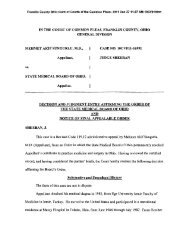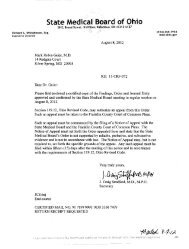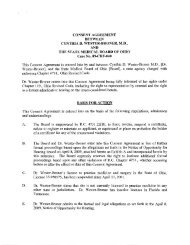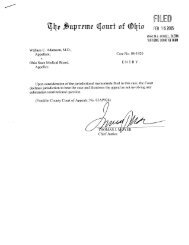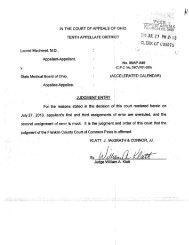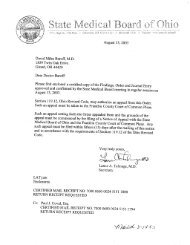CONSENT AGREEMENT BETWEEN - State Medical Board of Ohio ...
CONSENT AGREEMENT BETWEEN - State Medical Board of Ohio ...
CONSENT AGREEMENT BETWEEN - State Medical Board of Ohio ...
You also want an ePaper? Increase the reach of your titles
YUMPU automatically turns print PDFs into web optimized ePapers that Google loves.
Matter <strong>of</strong> Kyle Elliott Hoogendoorn, D.P.M. Page 27<br />
Testimony and January 31, 2005, Report <strong>of</strong> Dr. Chelimsky<br />
58. Dr. Chelimsky testified that Dr. Hoogendoorn had performed procedures that were beyond<br />
the scope <strong>of</strong> practice <strong>of</strong> a podiatric physician. Dr. Chelimsky testified that chemoneurolytic<br />
and trigger point injections require the exercise <strong>of</strong> judgment based on medical knowledge.<br />
Dr. Chelimsky further testified that they require an individual assessment <strong>of</strong> each patient<br />
because trigger points vary in location from patient to patient, the risks are different from<br />
patient to patient, “and the agent choice will vary from one patient to the next.”<br />
Dr. Chelimsky further testified that they cannot be performed without a need for complex<br />
observations or critical decisions. Finally, such procedures “require repeated medical<br />
assessments to look at the results <strong>of</strong> the injection as far as pain is concerned, and also to<br />
make sure there hasn’t been a serious complication.” (Tr. at 1634, 1657-1665)<br />
Finally, Dr. Chelimsky testified concerning Dr. Hoogendoorn’s performance <strong>of</strong> injection<br />
procedures that his opinion does not change if Dr. Hoogendoorn had been performing these<br />
injections as a fellow because “that would imply he’s training to perform it, eventually.<br />
* * * The point <strong>of</strong> a fellowship program is to train somebody to do what they’re<br />
eventually going to do.” (Tr. at 1648-1649)<br />
Testimony <strong>of</strong> Dr. Bressi<br />
59. Dr. Bressi believes that it had been appropriate for Dr. Hoogendoorn to administer trigger<br />
point and chemoneurolytic injections in the context <strong>of</strong> his pain fellowship. Dr. Bressi<br />
testified: “For podiatry it is extremely important that they get a handle on chronic pain<br />
because * * * many, if not the bulk, <strong>of</strong> their problems deal with pain in the feet. But not all<br />
the pain in the feet comes from the feet, and they have to be familiar with generalized<br />
systems.” (Tr. at 2320-2323, 2479-2480)<br />
60. Dr. Bressi testified that trigger point injections “could be catastrophic if you’re not<br />
careful.” For example, “in the thoracic area you have to watch that you don’t go too deep<br />
because you can collapse a lung[.]” Further, “[y]ou don’t want to get a [blood] vessel.<br />
You can have a seizure or somebody can stroke.” Dr. Bressi further testified that either<br />
Dr. Leak or Dr. Griffin had to have been in the room with Dr. Hoogendoorn at first to show<br />
him how they are done and observe his performance. After that, they would not necessarily<br />
have to be in the room with him. (Tr. at 2480-2482)<br />
Dr. Bressi further testified that, in his opinion, Dr. Hoogendoorn had been competent to<br />
perform trigger point injections and chemoneurolytic injections under the supervision <strong>of</strong><br />
Dr. Leak or Dr. Griffin. (Tr. at 2486)<br />
61. Dr. Bressi testified that, in his opinion, Dr. Hoogendoorn had not practiced medicine<br />
without a certificate by performing injections under the supervision <strong>of</strong> Dr. Leak or<br />
Dr. Griffin. Dr. Bressi testified that the basis <strong>of</strong> that opinion was that Dr. Hoogendoorn<br />
had been in a fellowship at the time he engaged in those activities. (Tr. at 2486-2487)



